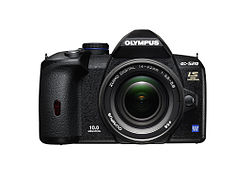 | |
| Overview | |
|---|---|
| Maker | Olympus Corporation |
| Type | Digital single-lens reflex |
| Lens | |
| Lens mount | Four Thirds |
| Lens | Interchangeable Four Thirds System |
| Sensor/medium | |
| Sensor | 18.00 x 13.50 mm Live MOS |
| Maximum resolution | 3648 × 2736 (10 megapixels) |
| Film speed | 100–1600 |
| Storage media | CompactFlash (CF) (Type I or Type II) + xD Picture Card |
| Focusing | |
| Focus areas | 3-point TTL Phase Diff |
| Exposure/metering | |
| Exposure modes | ESP multi-pattern, Center-Weighted, Spot, Highlight based spot, Shadow based spot |
| Shutter | |
| Shutter speed range | 60 s – 1/4000 s |
| Continuous shooting | 3.5 frame/s |
| Viewfinder | |
| Viewfinder | Optical TTL |
| General | |
| LCD screen | 2.7" TFT LCD, 230,000 pixels, live preview capable |
| Battery | BLM-1 Lithium-Ion rechargeable |
| Weight | 475 g (17 oz) (body only) |
| Made in | China |
The Olympus E-520 (or Olympus EVOLT E-520 in North America) is a 10 megapixel digital single-lens reflex (DSLR) camera.


